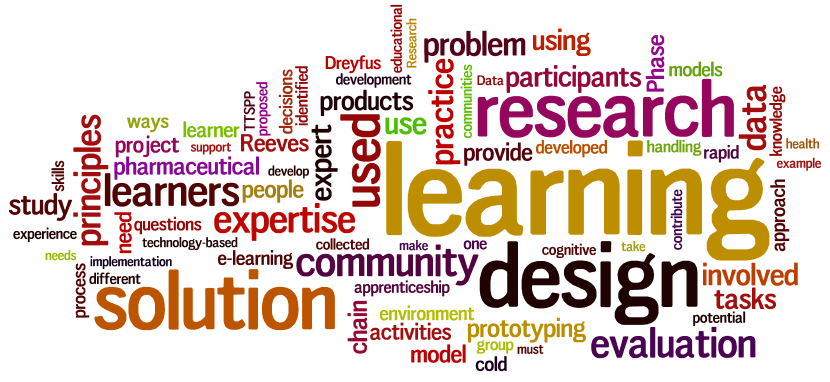James Vesper
Developing expertise of those handling temperature-sensitive pharmaceutical products using e-learning
THESIS DOWNLOAD:
Abstract
The use of e-learning as a means of providing academic and professional education and training continues to expand. New technologies allow for innovative instructional approaches, while different instructional approaches catalyze the development of alternative technologies or the repurposing of existing ones. The effort and expense of creating e-learning courses demand that instead of a haphazard design approach or simply duplicating a course using a model that currently exists, developers consider and incorporate a valid theoretical foundation for what they produce.
The purpose of this research was to create an e-learning course—based on theoretical design principles derived from the research literature—that would contribute to the expertise of those handling time- and temperature-sensitive pharmaceutical products (such as vaccines). The e-learning course was based on an existing physical course conducted annually by the World Health Organization in Turkey, but the approach adopted was based on theory and practice more appropriate to online learning. Three learning theories provided the theoretical underpinnings for the study: cognitive apprenticeship, authentic learning, and community of learners.
A design-based research approach was used to conduct the study and create the e- learning solution. Draft design principles were established from the literature and consultations with practitioners, and incorporated and refined throughout the study as the e-learning solution moved from early sketches, a working “alpha” version,” and finally a field test of the working prototype. At each stage, formative evaluations were conducted with the results used to improve the subsequent iterations of the e-learning course.Interviews and surveys of the learners (participants) and instructors (mentors), learning assignments, diary entries, and researcher observations formed the data that were used and analyzed using semi-quantitative and qualitative techniques. The results were applied to improve subsequent iterations of the course design, including the user!iiiinterface, learner tasks and activities, and the interactions between the mentors and participants. Additionally, the results supported the refinement and restructuring of the design principles, which was a major outcome of the research.
The results of this study showed that an e-learning course could be based on an existing physical course, but in doing so, efforts should be made not to simply mirror the new course to the old, but rather to take maximum advantage of the affordances of each mode. Creating an authentic environment with authentic tasks and activities requires close consultation with practitioners in the field and a degree of suspension of disbelief by the learners which is accomplished by effectively communicating the context (or backstory) and the role(s) that they must take in accomplishing the task. While many e- learning design and development efforts emphasize the technologies to be used, the findings here place a higher emphasis on the importance of relationships that participants and mentors establish and develop as they work virtually together to accomplish authentic tasks. The outcomes of the study include an effective e-learning environment ready for implementation under real world conditions and a set of 13 refined design principles.Implications for practice cohere around the refined design principles that will provide a theoretical and practical foundation for those who develop e-learning solutions in other education and training contexts, and to assist them to incorporate authentic activities in their own e-learning solutions.

Publications
Vesper, J.L., Kartoğlu, Ü., Herrington, J. & Reeves, T.C. (2015) Incorporating risk assessment into the formative evaluation of an authentic e-learning program. British Journal of Educational Technology, 47 (6). pp. 1113-1124.
Vesper, J.L., Herrington, J., Kartoğlu, U. & Reeves, T.C. (2015) Initial design principles for establishing a learning community for public health professionals through authentic e-learning. International Journal of Continuing Engineering Education and Life-Long Learning, 25 (2). pp. 241-257.
Vesper, J.L., Reeves, T. & Herrington, J. (2013) Using preliminary risk assessment in a formative evaluation. In: EdMedia 2013 World Conference on Educational Media and Technology, 24 - 27 June 2013, Victoria, BC, Canada pp. 407-412.
Vesper, J.L., Herrington, J., Kartoğlu, U. & Reeves, T.C. (2015) Initial design principles for establishing a learning community for public health professionals through authentic e-learning. International Journal of Continuing Engineering Education and Life-Long Learning, 25 (2). pp. 241-257.
Vesper, J.L., Reeves, T. & Herrington, J. (2013) Using preliminary risk assessment in a formative evaluation. In: EdMedia 2013 World Conference on Educational Media and Technology, 24 - 27 June 2013, Victoria, BC, Canada pp. 407-412.
Vesper, J. & Herrington, J. (2012). Considering communities of learners when creating an E-learning course.In T. Amiel & B. Wilson (Eds.), Proceedings of EdMedia 2012 (pp. 481-490). Chesapeake, VA: AACE
Vesper, J. & Herrington, J. (2011). Developing expertise in those handling time and temperature sensitive pharmaceutical products: Applying the early phases of a design research methodology.In T. Bastiaens & M. Ebner (Eds.), Proceedings of EdMedia 2011 (pp. 591-600). Chesapeake, VA: AACE.
Vesper, J., Reeves, T.C. & Herrington, J. (2011). The application of expert review as a formative evaluation strategy within an educational design research study. In Proceedings of World Conference on E-Learning in Corporate, Government, Healthcare, and Higher Education 2011 (pp. 973-978). Chesapeake, VA: AACE.